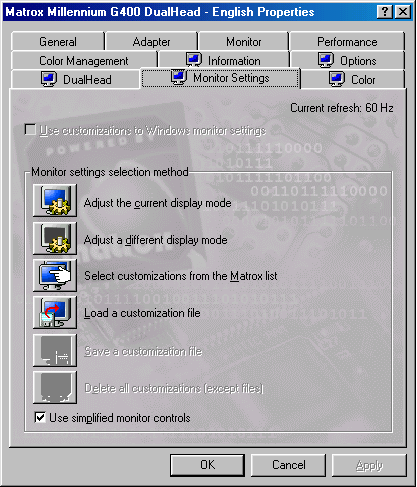Drivers & 2D Image Quality
As mentioned before, the G400 has a functional OpenGL ICD. The OpenGL ICD is for Windows 9x only (no NT yet) and is not a final candidate, meaning performance and stability still have room for improvement. AnandTech noticed a few texture problems with the OpenGL ICD under Quake 2, but overall the ICD seemed quite strong. Super7 support by the OpenGL ICD is scarce, and stability under OpenGL apps with Super7 systems is not too pleasing at all. AnandTech was informed by Matrox that they are working on stability issues with the ICD (there are a few) and they have assured AnandTech that the problems will be cleared up by the time the final drivers need to be complete.
In an impromptu interview at this year's E3, Matrox confirmed that G400 users would have Windows 2000 drivers upon the release of Microsoft's upcoming operating system, although they regretted to inform us that there were no Win2K drivers available as of now.
Support for AMD's 3DNow! instruction set will be provided in the final release candidates of the drivers as well as support for AMD's K7 and DirectX 6.2. Matrox is determined to make the G400 a please all solution, and the Super7/K7 market is one that truly does need a leader in the video industry with that sort of an attitude.
The 2D image quality of the G400 boards AnandTech received was top quality, partially due to the higher speed RAMDAC on the G400MAX (it allowed for higher resolutions to be achieved), but primarily because of the excellent manufacturing that went into the production of the boards themselves. Matrox takes the AnandTech Editor's Choice Award for Best Image Quality (2D & 3D) for their outstanding 2D image quality, coupled with superb 3D image quality as well. But what's an award without performance to back it up?
The Test
AnandTech received evaluation G400 and G400MAX boards from Matrox. The G400 was outfitted with 16MB of SDRAM, and the G400MAX with 32MB. The cards were compared to the 3dfx Voodoo3 2000/3000, Leadtek Winfast 3D S320-II 16MB TNT, and the Diamond Stealth III S540 32MB Savage4 cards. AnandTech's Slot-1/Socket-370 test configuration was as follows:
- Intel Pentium III 500, Intel Pentium II 400, Intel Pentium II 266, Intel Celeron 333, Intel Celeron 266 (0KB L2) on an ABIT BX6 Revision 2.0 or an ABIT ZM6 for the Socket-370 Celeron 333 tests.
- 64MB of Memman/Mushkin SEC Original SDRAM was used in each test system
- Western Digital 5.1GB Ultra ATA/33 HDD
- Microsoft Windows 98
AnandTech's Super7 test configuration differed only in the processor/motherboard used
- AMD K6-3 500, AMD K6-2 300, AMD K6-266
- ASUS P5A Aladdin V based Super7 Board w/ ALi AGP v1.54 drivers
The benchmark software used was as follows:
- id Software's Quake 2 Version 3.20 using demo1.dm2 and 3Finger's crusher.dm2
- Monolith's Shogo using 3Finger's RevDemo
- Interplay's Descent3 Demo2 using AnandTech's Descent3 Torture Demo could not be used, Matrox is investigating a problem with Descent 3 and the G400 at this time
Each benchmark was run a total of three times and the average frame rates taken. Vsync was disabled
All scores were taken at a 16-bit color depth and 16-bit Z-buffer unless otherwise stated
AnandTech used Matrox Millennium G400 DualHead driver revision 4.11.01.1100















0 Comments
View All Comments